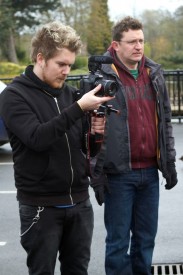Regular readers may (but probably won’t) remember that almost a year ago I interviewed indie filmmaker Kate Madison as part of a documentary I planned to make under the working title of “Living in a Fantasy World”. I should have realised that shooting a doc about people trying to make incredibly ambitious fantasy films on shoestring budgets was going to be a long, slow process, but I didn’t think it would be eleven months before I did my next bit of filming.

Yesterday I went up to Manchester to document the first day of shooting on Dan Rowbottom’s Dark Crystal-esque fantasy adventure Raven Waiting. In due course I will be sharing some of this footage with you, but today I want to share my thoughts on behind-the-scenes, or “B roll”, filming. Here are my top tips:
- Pace yourself. It’s tempting to film non-stop in the morning, generating far more shots of people unpacking equipment than the editor will ever need, and to neglect things later in the day. Try to cover the whole day evenly.
- Don’t get in the way and don’t film people if they ask you not to, but don’t be afraid to record the difficult conversations when things start to go pear-shaped.
- Like anyone crewing, remember your on-set etiquette. Say “crossing” when you pass in front of the A camera, and when it’s rolling stay silent, don’t cast shadows and don’t distract the talent.
- Remember that although you have a job to do, so does the main unit and theirs is much more important. Help them if they need it.
- Think about what people have said or might say in the interviews and capture appropriate shots for the editor to paste over these.
- If you can’t find a good angle to shoot from, don’t bother. There will be plenty of opportunities later in the day.
- Unless something particularly interesting is happening, ten seconds is long enough to hold a shot for. Don’t shoot long conversations unless you’re miking them properly; they won’t be useable.
- Pack fast lenses, f1.8 at least. Film sets are incredibly dark away from the lit area.
- Remember to cover the action away from the set – hair, make-up and wardrobe.
- Here are some shots you definitely shouldn’t go home without: the clapperboard clapping; the director calling “cut” and “action”; a cutaway of the camera being operated; the director pointing/looking thoughtfully at the monitor/giving an actor notes or otherwise demonstrably directing; actors preparing or mucking around between takes; an establishing shot of the location.